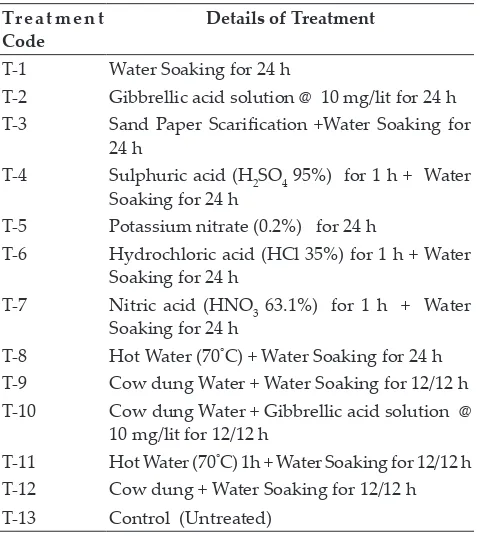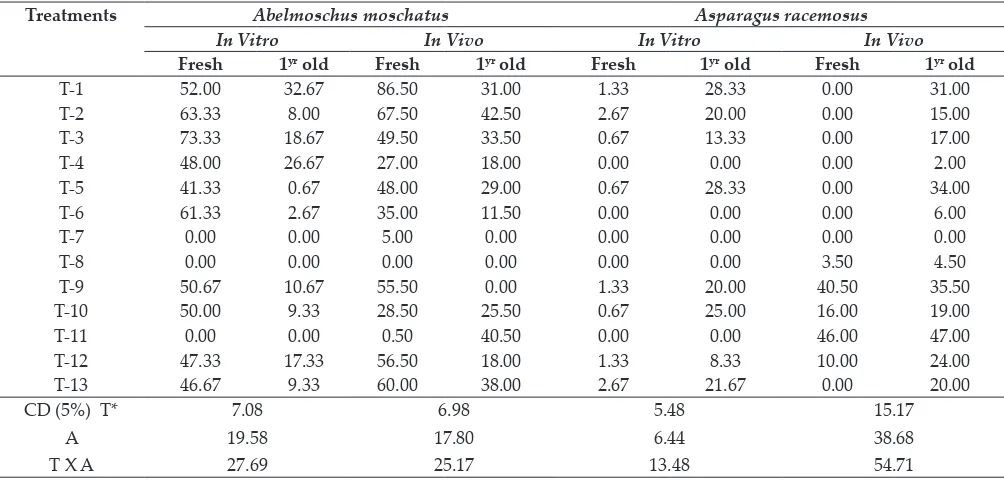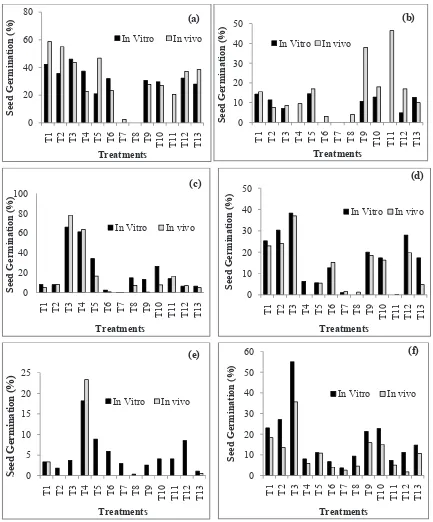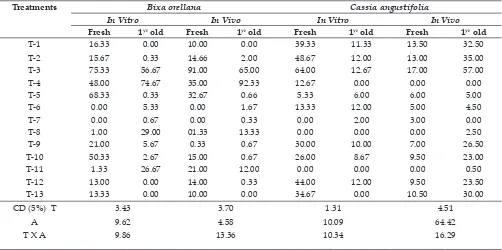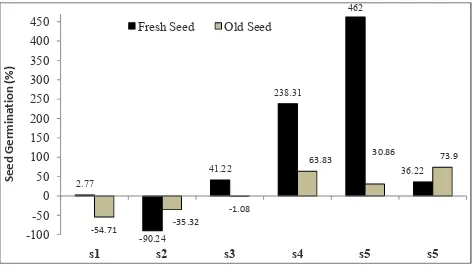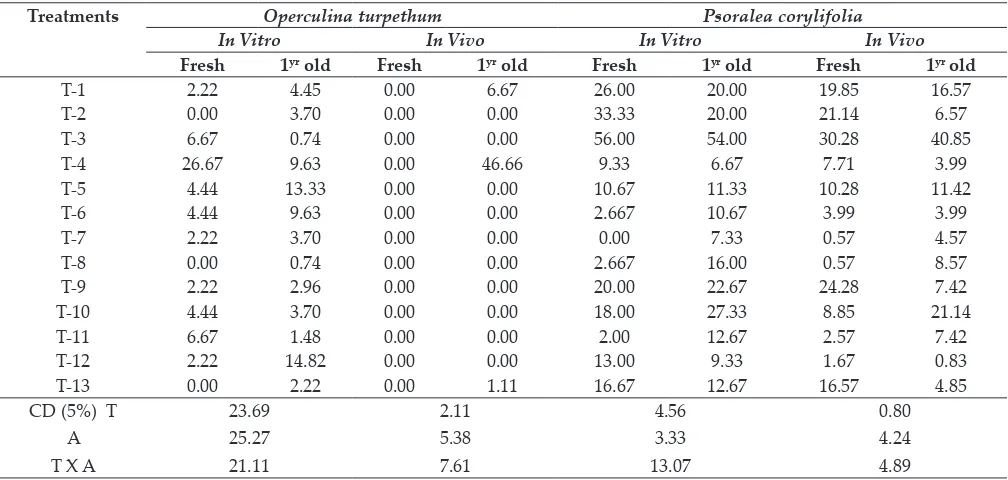DOI: 10.30954/0974-1712.04.2018.10
©2018New Delhi Publishers. All rights reserved
Techniques for Breaking Seed Dormancy and its Efficacy on
Seed Germination of Six Important Medicinal Plant Species
Raj Kumar Singh Tiwari
1, K.K. Chandra
2* and Satish Dubey
11TCB College of Agriculture and Research Station, (Indira Gandhi Krishi Vishwavidyalaya), Bilaspur, Chhattisgarh, India 2Department of Forestry, Wildlife and Environmental Sciences, Guru Ghasidas University, Bilaspur, Chhattisgarh, India *Corresponding author: kkckvk@gmail.com (ORCID ID: 0000-0002-0545-3397)
Paper No. 681 Received: 15-11-2017 Accepted: 16-03-2018
ABSTRACT
Present study deals the effectiveness of traditional and recent techniques of seed treatment on germination of fresh and year old seed of Abelmoschus moschatus, Asparagus racemosus, Bixa orellana,Cassia angustifolia, Operculina turpethum and Psoralea corylifolia under in vitro and in vivo conditions. Result indicates that seed treatments had significant positive impact on germination; however the effectiveness of the treatments varied among different medicinal species. There was 3 to 15 folds increment in percent germination due to seed treatments. Seed treatment with H2SO4, seed coat scarification by sand paper and seed soaking in normal water for 24 h rendered maximum germination, both in in vitro and in vivo conditions in most of the species under studied. Mean seed germination increased maximum 64.28%, 1460.0%, 115.40% and 274.94% in A. moschatus, B.orellana, C. angustifolia and P. corylifolia respectively over control. Seeds treated with hot water at 70°C for 1 h rendered 365% more germination in A. racemosus under in vivo, while O. turpethum seeds germinated maximum with H2SO4 95% under both in vitro and in vivo conditions. Highlights
mScarification of seed coat with sand paper was found the most effective in breaking seed dormancy method for A. moschatus, B. orellana, C. angustifolia and in P. corylifolia.
mSoaking of seeds in water for 24 h proved to be best in seed germination of A. racemosus. mSeed treatment with H2SO4 (95%) + water soaking observed best in O. turpethum.
mFreshly harvested seeds rendered higher germination in A. moschatus and B. orellana while one year old stored seeds of A. racemosus and O. turpethum germinated significantly higher.
mTreatment of Seeds before sowing improved percent germination in all seed of medicinal valued plant species.
Keywords: Germination, In vitro, In vivo, Medicinal plant, Seed dormancy
The industrial demand for the medicinal plant resources has been on the rise due to the worldwide buoyancy in the production of herbal health care formulations; cosmetics and nutritional supplements. In India, nearly 9,500 registered herbal industries and a multitude of unregistered Vaidya depends upon the sustainable supply of raw medicinal plants (Ved and Goraya, 2007). This demand can only be full filled when such plants are to be grown in farmer’s fields. Some medicinal plants viz. Abelmoschus moschatus, Asparagus racemosus, Bixa orellana,Cassia angustifolia, Operculina
turpethum and Psoralea corylifolia have growing interest among Indian farmers owing to higher income than other traditional crops as their use has been already established in curing of many diseases in human and animals since ancient time. Now the use of herb products is gaining momentum globally to avoid adverse effects of allopathic medicine. Medicinal plants are propagated mainly through seed, which suffers dormancy (Ramamoorthy et al. 2005; Pallavi et al. 2014)using different species, while some medicinal species only germinates in their native habitat. Breaking of seed originated
dormancy is very essential for plant population and eventually yield. To break seed dormancy our fore father were used locally available methods in agriculture viz. cow urine, rubbing of seed with stones, passing of seed through animal stomach etc., are still relevant even in modern time. However, now growth regulator, acid methods, radiation techniques being replaced our indigenous traditional knowledge (ITKs). Other scientists Patane and Grestab (2006) and Kaef et al. (2011) has reported the beneficial effects of growth regulators and chemicals in breaking of seed dormancy in medicinal plants. Similarly mechanical scarification with sand paper (Ali et al. 2011), hot water (Olmez et al. 2008; Rahnama and Tavakkol-Afshari, 2007) and perforation of seed coat (Aliero, 2004; Sari et al. 2006; Heidari et al. 2008) have been also advocated for certain medicinal plant species. As for as literature
survey could ascertain, study on seed germination
was lacking on these species especially depicting both traditional and recent techniques. Therefore, the present investigation aimed to track best method in breaking dormancy of some important medicinal plants either fresh or year aged seeds under in vitro
and in vivo conditions were evaluated.
MATERIALS AND METHODS
The present experiment was carried out at the Experimental Farm of Thakur Chhedilal Barrister College of Agriculture and Research Station, Bilaspur, Chhattisgarh, India lies in 22°9’12”
North latitude and 82° 12’12” East longitude at
South Eastern Central Zone of India. The climate of Bilaspur is sub humid and temperature varies from a minimum of 4.6°C (in December-January)
to a maximum of about 45°C (in May) with average
annual rainfall 1250 mm.
Seed source:Fresh seeds of Abelmoschus moschatus,
Asparagus racemosus, Bixa orellana,Cassia angustifolia, Operculina turpethum and Psoralea corylifolia were collected from medicinal plant nursery inside the college campus. One year aged seeds of the same species were also collected from the same nursery, which were stored year before in plastic box at room temperature.
Treatments: The experiment consisting of two
factors viz. Seed age as first factor (fresh and one year old) and treatments as second factor under
and in vivo (Nursery field condition). The treatments applied in the present experiment of medicinal plants is given in table 1.
Table 1: Treatment details and its combinations undertaken in the experiment.
Treatment
Code Details of Treatment
T-1 Water Soaking for 24 h
T-2 Gibbrellic acid solution @ 10 mg/lit for 24 h T-3 Sand Paper Scarification +Water Soaking for
24 h
T-4 Sulphuric acid (H2SO4 95%) for 1 h + Water Soaking for 24 h
T-5 Potassium nitrate (0.2%) for 24 h
T-6 Hydrochloric acid (HCl 35%) for 1 h + Water Soaking for 24 h
T-7 Nitric acid (HNO3 63.1%) for 1 h + Water Soaking for 24 h
T-8 Hot Water (70°C) + Water Soaking for 24 h T-9 Cow dung Water + Water Soaking for 12/12 h T-10 Cow dung Water + Gibbrellic acid solution @
10 mg/lit for 12/12 h
T-11 Hot Water (70°C) 1h + Water Soaking for 12/12 h T-12 Cow dung + Water Soaking for 12/12 h T-13 Control (Untreated)
Seed coats were scarified manually with sandpaper for 1 minute and then the seeds were soaked in normal tap water for 24 h at room temperature. In acid treatments, seeds were soaked separately in H2SO4 (95%), Nitric acid (HNO3 63.1%) and Hydrochloric acid (HCl 35%) for 1 h then washed thrice with tap water and soaked in normal distilled water further for 24 h. Gibbrellic acid (10 mg/l) and Potassium nitrate (0.2%) were used for 24 h presoaking of seeds at room temperature. For hot water treatment, the seeds were placed in a cotton cloth bag and were kept in water bath at 70°C for
1 h followed by keeping in water for 24 h at room temperature while hot water followed by chemical Treatments, seeds were placed in water both at 70°C
for 1 h than seed soaked in Gibbrellic acid solution (10 mg/l) for 24 h. Seed of medicinal plants were also subjected to cow dung water treatments. Fresh cow dung was dried under sunlight for three days followed by autoclaved at 121.6°C. 100 g of sterilized
soaked in this solution for 12 h. After 12 hours, seeds were placed in Gibbrellic acid solutions for another 12 h as per the requirement of treatments. Some seeds were kept in fresh cow dung for 12 h there after seeds were transferred to sterilized water for another 12 h.
Experimental design, data parameter and analysis
In vitro and in vivo conditions, all treated seeds
were sown in two factors in completely randomized design with three replications. Observations were recorded on germination. Different treatment combinations were applied to break seed dormancy using mechanical, physical and chemical methods. Fifty treated seeds along with 50 untreated seeds were kept in Petri plates having moist filter paper and 5 to 7 ml, sterilized water was further added at an interval of 24 h to provide suitable moisture for germination. Entire experiment was replicated thrice and kept in vitro and germination (%) was recorded after three days of incubation and continued for 18 days. In vivo, treated and untreated seeds (100 seeds / treatment) were sown in nursery beds as per randomized design with three replications and data was recorded after 15 days of sowing and continued up to 45 days. The data recorded was subjected to statistical analysis using SPSS software.
RESULTS AND DISCUSSION
Germination of all medicinal plants significantly influenced with seed treatments; however variation existed among species, treatments and conditions maintained for the experiments. The results data are summarized in table 2 to 4 and Fig. 1 to 3. Mean
germination of A. moschatus found highest 58.75% with soaking of seeds in water for 24 h and kept
under in vivo condition, while sand paper + water soaking gave highest germination 46.0% under
in vitro compared to control seeds (Table 2 and Fig. 1a). No germination observed in seeds with Hot water +GA3 under both in vitro and in vivo
conditions. HNO3 and hot water treated seeds also
failed to germinate under in vitro condition. Fresh seeds were significantly more than old seeds of A.
moschatus as mean germination was 292.63% and 80.65% higher under inviro and in vivo conditions
respectively compared to year aged seeds (Fig. 1a).
In A. moschatus seed germination found 2.77% more
under in vitro than in vivo condition in case of fresh
seeds, while old seeds were germinated better under
in vivo condition as -52.71% less germination was
found under in vitro condition in old seeds (Fig. 3). Seed germination result of Asparagus racemosus is
summarized in Table 2 and Fig. 1b. It was observed that the overall seed germination of the species was very poor however, Hot Water + Water Soaked
Table 2: Effect of seed treatments on germination percentage of Abelmoschu smoschatus and Asparagus racemosus
Treatments Abelmoschus moschatus Asparagus racemosus
In Vitro In Vivo In Vitro In Vivo
Fresh 1yr old Fresh 1yr old Fresh 1yr old Fresh 1yr old
T-1 52.00 32.67 86.50 31.00 1.33 28.33 0.00 31.00
T-2 63.33 8.00 67.50 42.50 2.67 20.00 0.00 15.00
T-3 73.33 18.67 49.50 33.50 0.67 13.33 0.00 17.00
T-4 48.00 26.67 27.00 18.00 0.00 0.00 0.00 2.00
T-5 41.33 0.67 48.00 29.00 0.67 28.33 0.00 34.00
T-6 61.33 2.67 35.00 11.50 0.00 0.00 0.00 6.00
T-7 0.00 0.00 5.00 0.00 0.00 0.00 0.00 0.00
T-8 0.00 0.00 0.00 0.00 0.00 0.00 3.50 4.50
T-9 50.67 10.67 55.50 0.00 1.33 20.00 40.50 35.50
T-10 50.00 9.33 28.50 25.50 0.67 25.00 16.00 19.00
T-11 0.00 0.00 0.50 40.50 0.00 0.00 46.00 47.00
T-12 47.33 17.33 56.50 18.00 1.33 8.33 10.00 24.00
T-13 46.67 9.33 60.00 38.00 2.67 21.67 0.00 20.00
CD (5%) T* A T X A
7.08 19.58 27.69
6.98 17.80 25.17
5.48 6.44 13.48
seeds germinated highest 46.50% and Cow dung water + Water Soaked seed germinated 38.0% were the most effective treatment under in vivo as
compared to control seeds and water soaked seeds for 24 h rendered highest mean germination 14.83%
under in vivo compared to control seeds which recorded 12.67% and 10.0% germination under in
In A. racemosus, fresh seeds germinated poorly than year aged seeds (mean germination 0.87 and 8.92% in fresh seeds and 12.69 and 19.62% in old seeds respectively (Fig. 2)). In addition, in vivo condition
was found to be more suitable in seed germination
than in vitro condition when compared with their respective categories (Fig. 3).
0 20 40 60 80
T1 T2 T3 T4 T5 T6 T7 T8 T9 T10 T11 T12 T13
Se ed G er m in at io n (% ) Treatments (a)
In Vitro In vivo
0 10 20 30 40 50
T1 T2 T3 T4 T5 T6 T7 T8 T9 T10 T11 T12 T13
Se ed G er m in at io n (% ) Treatments (b)
In Vitro In vivo
0 20 40 60 80 100
T1 T2 T3 T4 T5 T6 T7 T8 T9 T10 T11 T12 T13
Se ed G er m in at io n (% ) Treatments (c)
In Vitro In vivo
0 10 20 30 40 50
T1 T2 T3 T4 T5 T6 T7 T8 T9 T10 T11 T12 T13
Se ed G er m in at io n (% ) Treatments (d)
In Vitro In vivo
0 5 10 15 20 25
T1 T2 T3 T4 T5 T6 T7 T8 T9 T10 T11 T12 T13
Seed
Germination (%
)
Treatments
(e)
In Vitro In vivo
0 10 20 30 40 50 60
T1 T2 T3 T4 T5 T6 T7 T8 T9 T10 T11 T12 T13
Se ed G er m in at io n (% ) Treatments (f)
In Vitro In vivo
Fig. 1: Mean seed germination (%) after different seed treatment in (a) A. moschatus (b) A. racemosus (c) Bixa orellana (d) C.
Bixa orellana seeds treated with different physical and chemical methods are given in Table 3 and Fig. 1c. It indicates that the highest 92.33% germination found in seeds treated with H2SO4 + water soaking
under in vivo and 75.33% with sand paper + water soaking under in vitro condition. Maximum seed germination in control seeds found 13.33% under in vitro and 10% under in vivo condition, which depicts the positive efficacy of seed treatments in enhancing seed germination (Table 3).
Mean seed germination was maximum 78% with sand paper + water soaking under in vivo and 66% with the same treatments under in vitro condition
(Fig 1c). It was observed that the fresh seeds germination 60.14% and 12.16% higher than the
germination in aged seeds under in vitro and in vivo
condition respectively (Fig. 2). Overall, fresh seeds geminated 41.22% higher under in vitro condition than in vivo, while no change in the germination of old seeds under both the conditions (Fig. 3). Seed germination in C. angustifolia was found very poor germination even after using various seed treatment techniques, however only few treatments exhibited positive results (Table 3). Mean germination was enhanced from 17.33 of control to 38.33% in seeds treated with sand paper + water soaking under in vitro and similarly 20.25%
to 37.0% under in vivo with the same techniques which was found 115.40% and 678.94% higher mean germination than its controls. (Fig. 1d). The germination of fresh seed was 266.71% higher than
old seeds under in vitro while old seeds germinated better under in vivo condition (Fig. 2).
0 10 20 30 40 50
F O F O F O F O F O F O
S1 S2 S3 S4 S5 S6
Se
ed
G
er
m
in
at
io
n
(%
)
In Vitro In Vivo
Fig. 2: Mean Seed Germination (%) in fresh seed (F) and old
seeds (O) of (s1) A. moschatus (s2) A. racemosus (s3) B. orellena
(s4) C. angustifolia (s5) O. turpethum and (s6) P. corylifolia
Some other treatments viz. Gibbrellic acid and water soaking of seeds for 24 hrs also found to be beneficial in breaking seed dormancy as compared to control seeds. The mean germination of fresh seeds was 238.32% higher under in vitro than
Table 3: Effect of seed treatments on germination percentage of Bixa orellana and Cassia angustifolia
Treatments Bixa orellana Cassia angustifolia
In Vitro In Vivo In Vitro In Vivo
Fresh 1yr old Fresh 1yr old Fresh 1yr old Fresh 1yr old
T-1 16.33 0.00 10.00 0.00 39.33 11.33 13.50 32.50
T-2 15.67 0.33 14.66 2.00 48.67 12.00 13.00 35.00
T-3 75.33 56.67 91.00 65.00 64.00 12.67 17.00 57.00
T-4 48.00 74.67 35.00 92.33 12.67 0.00 0.00 0.00
T-5 68.33 0.33 32.67 0.66 5.33 6.00 6.00 5.00
T-6 0.00 5.33 0.00 1.67 13.33 12.00 5.00 4.50
T-7 0.00 0.67 0.00 0.33 0.00 2.00 3.00 0.00
T-8 1.00 29.00 01.33 13.33 0.00 0.00 0.00 2.50
T-9 21.00 5.67 0.33 0.67 30.00 10.00 7.00 26.50
T-10 50.33 2.67 15.00 0.67 26.00 8.67 9.50 23.00
T-11 1.33 26.67 21.00 12.00 0.00 0.00 0.00 0.50
T-12 13.00 0.00 14.00 0.33 44.00 12.00 9.50 23.50
T-13 13.33 0.00 10.00 0.00 34.67 0.00 10.50 30.00
CD (5%) T A T X A
3.43 9.62 9.86
3.70 4.58 13.36
1.31 10.09 10.34
4.51 64.42 16.29
germination of fresh seeds under in vivo, while year aged seed performed higher germinated under in vivo condition (Fig. 3).
2.77
-90.24 41.22
238.31 462
36.22
-54.71 -35.32 -1.08
63.83 30.86 73.9
-100 -50 0 50 100 150 200 250 300 350 400 450
s1 s2 s3 s4 s5 s5
Se
ed
G
er
m
in
at
io
n
(%
)
Fresh Seed Old Seed
Fig. 3: Mean Seed Germination (%) of (s1) A. moschatus (s2) A.
racemosus (s3) B. orellena (s4) C. angustifolia (s5) O. turpethum
and (s6) P. corylifolia seeds when compared with invitro and
invivo conditions in its respective fresh and old seeds
The germination of Operculina turpethum seed was found to be extremely low in most of the treatments
under in vivo condition even after treatments. However, under in vivo condition, H2SO4+ water
soaking was found highly effective in improving the mean germination by 41.48 folds (in vivo) and 15.35 folds (in vitro) over control seeds. The highest germination recorded 46.66% in year aged seeds
under in vivo and 26.67% in fresh seeds under in vitro in H2SO4+ water soaking treated seeds (Table 4), while mean germination in control seed was found 1.11% (in vitro) and 0.50% (in vivo) (Fig. 1e). It was also observed that fresh seeds germination was -15.53% poor than old seeds under in vitro while no fresh seeds were germinated under in vivo (Fig. 2), this indicated the superiority of old seeds as compared to fresh O. turpethum seeds. Seeds grown
under in vitro condition rendered 462% and 30.86%
higher germination in fresh seed and old seeds
respectively in comparison to seed germination
under in vivo condition (Fig. 3).
In Psoralea corylifolia, different seed treatments
had significant positive effect on germination as compared to untreated seed (Table 4). Seed coat scarification with sand paper + water soaking was found to be most effective and showed significantly highest mean germination (55.0%) under in vitro
and under in vivo (35.57%) conditions (Fig. 1f), these were 274.91% and 232.42% higher over germination in control seeds. Gibbrellic acid, Cow dung + water soaking and water soaking for 24
h also found to induce germination significantly than other treatments. Mean germination in fresh seeds was -9.10% poor than aged seeds under in vitro, but fresh seeds germinated 16.03 % higher
than old seeds under in vivo (Fig. 2). Comparing the seed germination between in vitro and in vivo
condition, germination under in vitro was superior
as mean germination under in vitro was 36.22% (fresh seed) and 73.90% (old seed) higher compared
to germination under in vivo condition (Fig. 3). Present study justifies the significance of different treatments in breaking seed dormancy and enhancing seed germination in all six medicinal plants. However, the effectiveness of treatments varied in different species which indicates the needs of specific treatment for each species. Amongst 13 treatments, few of them significantly enhance the germination, while others were found ineffective compared with untreated control seeds. This indicates the necessity of seed treatment with their integrated combinations before sowing.
Sand paper followed by water soaking was found most effective for B. orellana, C. angustifolia and P. corylifolia both under in vitro and in vivo conditions
compared to other treatments. This indicates the significance of rupturing seed coat surface to allow, water and oxygen readily to the embryo resulted into higher germination (Cavanagh 1980). Baskin and Baskin (2004) have also reported seed coat dormancy in 16 families of angiosperm causes delayed or no germination. Poor germination of control seed might be due to the presence of this reason. Several other workers have propounded sand paper scarification as one of the effective method in breaking dormancy in many plant species (Kaef et al. 2011; Ali et al. 2011; Kildisheva et al. 2011;
Venier et al. 2012; Zare et al. 2011).
Seed underwent soaking in water for 24 h too
rendered highest mean germination in A.moschatus,
A. racemosus and P. corylifolia while, second most
effective treatments in C. angustifolia and in O.
increase in nucleic acid metabolism and protein synthesis (Jackson 1994).
Acid scarification techniques have been already proved beneficial for breaking seed dormancy and enhancing germination by many workers (Levit 1974; Sovler and Khawar 2006). In O. turpethum
H2SO4 (95%)followedwith water soaking was found most effective while other treatments were ineffective. B. orellana was also influenced with the same acid also concord with other findings (Levit 1974; Youssef 2008) as the concentrated H2SO4 also
disrupts the seed coat and improves germination. Actually, this acid is thought to disrupt the seed coat and expose the lumens of the macrosclereids cells, permitting imbibitions of water (Nikoleave 1977) which triggers germination as in case of
Prosopiskoelziana and P.juliflora (Sovler and Khawar 2006), Parkia biglobosa (Aliero 2004) and Cassia fistula
(Kandya 1999; Al-Menaie et al. 2010). KNO3 0.2% for 24 h was also effective in A. racemosus and O. turpethum might possibly through oxidized forms of nitrogen causing a shift in respiratory metabolism to the pentose phosphate pathway (Robert and Smith 1977).
Hot water at 70°C for 1 h followed by keeping seeds
in water for another 24 h at room temperature had a positive effect on germination of A. racemosus
germination increased from 10% to 46.5% under in
vivo probably due to softened hard and thick seed coat. The contact of seeds with hot water rapture the coat wall allowing water to permeate the seed tissues causing physiological changes results rapid germination of the embryo (Sabongari 2001; Rincon
et al. 2003). The adverse effects of hot water were also observed in present study except in A. racemosus
(in vivo), B. orellana (in vitro) and O. turpethum (in vitro) might be because of the long duration contact of seed with hot water results damage of embryo. Similar result was also reported in A. africana when seeds were treated with 100°C hot water for 12 h
(Amusa 2011).
GA3 a growth promoting hormone acts as stimulant for embryos also confirmed our findings in A. moschatus (in vivo) and P. corylifolia (in vitro) as similar to results propounded by several researchers (Zhang and Maun 1990; Chen et al. 2005; Tzortzakis 2009). Pre sowing treatment with GA3 under in vivo condition stimulated seed germination in A. moschatus might be due to altered physiology of embryos and activation of enzymes (Kattimani et al. 1999; Salisbury and Ross 2000).
Fresh seeds of A. moschatus, B. orellana, C. angustifolia
(in vitro), P. corylifolia (in vivo) showed significantly higher germination than old seed. These variations in germination may be related to the types of seed coat and level of dormancy in different medicinal Table 4: Effect of seed treatments on germination percentage of Operculina turpethum and Psoralea corylifolia
Treatments Operculina turpethum Psoralea corylifolia
In Vitro In Vivo In Vitro In Vivo
Fresh 1yr old Fresh 1yr old Fresh 1yr old Fresh 1yr old
T-1 2.22 4.45 0.00 6.67 26.00 20.00 19.85 16.57
T-2 0.00 3.70 0.00 0.00 33.33 20.00 21.14 6.57
T-3 6.67 0.74 0.00 0.00 56.00 54.00 30.28 40.85
T-4 26.67 9.63 0.00 46.66 9.33 6.67 7.71 3.99
T-5 4.44 13.33 0.00 0.00 10.67 11.33 10.28 11.42
T-6 4.44 9.63 0.00 0.00 2.667 10.67 3.99 3.99
T-7 2.22 3.70 0.00 0.00 0.00 7.33 0.57 4.57
T-8 0.00 0.74 0.00 0.00 2.667 16.00 0.57 8.57
T-9 2.22 2.96 0.00 0.00 20.00 22.67 24.28 7.42
T-10 4.44 3.70 0.00 0.00 18.00 27.33 8.85 21.14
T-11 6.67 1.48 0.00 0.00 2.00 12.67 2.57 7.42
T-12 2.22 14.82 0.00 0.00 13.00 9.33 1.67 0.83
T-13 0.00 2.22 0.00 1.11 16.67 12.67 16.57 4.85
CD (5%) T A T X A
23.69 25.27 21.11
2.11 5.38 7.61
4.56 3.33 13.07
plants. Freshly collected seeds might have great potential while they are slightly immature will have thinner seed coats often germinates better (Asi et al. 2011), resembles to our findings. One year aged seeds might accumulate some chemical substance in seed coat after exposure to environment, which probably makes them impervious, harder, results poor germination. However two species
A. racemosus and O. turpethum showed higher germination employing aged seeds, probably due to undeveloped embryo, which required some time to be mature and have extra advantages, that their seeds can be stored for longer period of time maintaining viability (Zhang and Maun 1999). Similarly variations on germination existed between
in vitro and in vivo condition of the experiment among species and age of the seedlings.
CONCLUSION
Understanding germination requirements of medicinal plant species is one of the most important steps in the survival of these species. Findings of our
study revealed that seed dormancy of all medicinal
species under study is caused by hard and water impermeable seed coat. A high level of germination was observed by using traditional scarification technique of seed coat and making it permeable to water and oxygen though various methods. It was found that mechanical scarification with sand paper was the most effective dormancy breaking
methods for A. moschatus, B. orellana, C. angustifolia
and in P. corylifolia seeds. Soaking of seed in water for 24 h was also proved best for A. racemosus and
H2SO4 (95%) + water soaking for O. turpethum. Based on the results it may be concluded that each species requires specific methods of seed treatments depending on the types of dormancy, however, scarification of hard seed coat using H2SO4 or sand
paper may be applied.
In general old indigenous knowledge of seed priming by soaking of seeds in water for 12 h may also be advisable for higher seed germination medicinal seeds.
ACKNOWLEDGEMENTS
A financial support was gratefully received from the Chhattisgarh Council of Science and Technology, Raipur, C.G., India.
REFERENCES
Ali, H., Tanveer, A., Nadeem, M.A. and Asghar, H.N. 2011. Methods to break seed dormancy of Rhynchosia capitata, a summer annual weed. Chilean Journal Agriculture Research, 71(3): 483-487.
Aliero, B. 2004. Effects of sulphuric acid, mechanical scarification and wet heat treatments on germination of seeds of African locust bean tree, Parkia biglobosa.African Journal Biotechnology,3(3): 179-181.
Al-Menaie, H.S., Al-Ragam, O., Al-Shatti, A., Mathew, M. and Suresh, N. 2010. The effects of different treatments on seed germination of Cassia fistula and Cassia nodosa Buch. Ham ex. Roxb. in Kuwait. African Journal Agricultural Research, 5(3): 230-235.
Amusa, T.O. 2011. Effects of three pre-treatment techniques on dormancy and germination of seeds of Afzelia africana. Journal Horticulture and Forestry,3(4): 96-103.
Asi, B.M., Sharivivash, R. and Rahbari, A. 2011. Effects of different treatments on seed germination of Honey locust (Gleditschia triacanthos). Modern Applied Sciences, 5(1): 200-204.
Baskin, J.M. and Baskin, C.C. 2004. A classification system for seed dormancy. Seed Science Research,14: 1-16.
Cavanagh, A.K. 1980. A review of some aspects of the germination of Acacias. Proc Royal Society Victoria, 91: 161-180.
Chen, D., Gunawardena, T.A., Naidu, B.P., Fukais and Basnayake, J. 2005. Seed treatment with gibberellic acid and glycinebetaine improves seedling emergence and seedling vigour of rice under low temperature. Seed Science Technology,33: 471-479.
Heidari, M., Rahemi, M. and Daneshvar, M.H. 2008. Effects of mechanical, chemical Scarification and stratification on seed germination of Prunus scoparia (Spach.) and Prunus webbii (Spach.) Vierh. American-Euriasian Journal Agriculture Environmental Science,3(1): 114-117.
Jackson, M.B. 1994. Root-to-shoot communication in flooded plants. Involvement of Abscisic acid, ethylene and 1-aminocy clopropane-1-carboxylic acid. Agronomy Journal,86(5) : 775-781.
Kandya, S. .1999. Mechanism of scarification to remove mechanical and physical dormancy of seeds in some important forest tree species. Journal of Tropical Forestry, 6(11): 242-247.
Kattimani, K.N., Reddy, Y.N. and Rao, R.B. 1999. Effect of presoaking seed treatment on germination, seedling emergence, seedling vigour and root yield of Aswagandha (Withania somnifera). Seed Science Technology,27: 483-488. Khaef, N., Sadeghi, H. and Taghvaei, M. 2011. Effects of new
strategies for breaking dormancy of two annual medics (Medicago scutellata and Medicago polymorpha). American-Eurasian Journal Agriculture Environmental Science,11(5): 626-632.
Sphaeralcea munroana seeds. Horticulture Science,46(12): 1672–1676.
Levitt, J. 1974. Introduction to plant Physiology, CV Mosby Company, USA: 277-286.
Nikoleave, M.G. 1977. Factor controlling seed dormancy pattern. North Holland Publishing Co, Amsterdam. Olmez, Z., Yahyaoglu, Z., Temel, F. and Gokturk, A. 2008.
Effects of some pretreatments on germination of bladder-senna (Colutea armena Boiss and Huet.) and smoke-tree (Cotinus coggygria Scop.) seeds. Journal Environmental Biology29(3): 319-323.
Pallavi, H.M., Vishwanath, K., Harish, B.S., Prashanth, Y. and Thattimani, M.N. 2014. Seed treatments to break seed dormancy and Standardization of viability test procedure in Abrus precatorious. Journal Medicinal Plant Research,8(4): 229-236.
Patane, C. and Grestab, F. 2006. Germination of Astragalus hamosus and Medicago orbicularis as affected by seed-coat dormancy breaking techniques. Journal of Arid Environment,67: 165-173.
Rahnama, A. and Tavakkol-Afshari, R. 2007. Methods for dormancy breaking of galbanum seeds (Ferula gummosa). Asian Journal Plant Science,6: 611-616.
Ramamoorthy, K., Rajendran, C. and Sivasubramanian, S. 2005. Seed treatment for alleviation of hard seededness in Senna (Cassia aungustifolia L.). Advances in Plant Science 18(1): 429-430.
Rincon, R., N. Culebro, F.A., Gutierrez and Dendooven, L. 2003. Scarification of seeds of Acacia angustissima Mill Kuntze and its effect on germination. Seed Science and Technology,31: 301-307.
Robert, S.E. and Smith, R.D. 1977. Dormancy and the pentose phosphate pathway, P 385–411. In. Khan A. (ed.), the Physiology and Biochemistry of Seed Dormancy and Germination. North-Holland Publishing Co., Amsterdam. Sabongari, S. 2001. Effect of Soaking duration on germination
and seedling establishment of selected varieties of Tomato (Lycopersicum esculentum Mill). M.Sc. Thesis, Department of Biological Sciences, Usmanu Danfodiyo University, Sokoto, Nigeria.
Salisbury, F. and Ross, C. 2000. Fisiologia de las plants. A. Alonso. Primera edicion. Editorial Paraninofo Thomson Learning. Espana. P. 988.
Sari, A., Oguz, B. and Bilgic, A. 2006. Breaking seed dormancy of laurel (Laurus nobilis L.). New Forest,31: 403–408. Soyler, D. and Khawar, K.M. 2006. Effects of prechilling,
scarification, incubation temperature, photoperiod, KNO3 and GA3 treatments on germination of caper (Capparis ovata Desf. var. Palaestina Zoh.) seeds. Propagation of Ornamental Plant,6: 159-164.
Tzortzakis, N.G. 2009. Effect of pre-sowing treatment on seed germination and seedling vigour in endive and chicory. Horticulture Science. (Prague) 36(3): 117-125.
Ved, D.K. and Goraya, G.S. 2007. Demand and Supply of Medicinal Plants in India. NMPB, New Delhi and FRLHT, Bangalore, India. M/S Bisen Singh Mahendra Pal Singh Publisher, Dehradun, p. 211.
Venier, P., Funes, G. and Garcia, C.C. 2012. Physical dormancy and histological features of seeds of five Acacia species (Fabaceae) from xerophytic forests in Central Argentina. Flora,207: 39-46.
Xu, L., Boe, A., Johnson, P.S. and Kephart, K. 2004. Effects of a naturalized population of Yellow flowered alfaala on species richness and biomass production of native rangeland, In beef cattle research report, SDSU, Bookings, P. 95.
Youssef, A.M. 2008. Adaptive responses of some desert plants from different ecosystems of Suez road. Egyptian Research Journal Agricultural and Biological Science,4(5) : 595-603. Zare, S., Tavili, A. and Darini, M.J. 2011. Effects of different
treatments on seed germination and breaking seed dormancy of Prosopis koelziana and Prosopis juliflora.Journal of Forest Research,22(1): 35-38.
Zhang, J. and Maun, M.A. 1990. Seed size variation and its effects on seedling growth in Agropyron psammophilum.
Botanical Gazette,151: 106–113.
Zhang, J. and Maun, M.A. 1999. Seed size variation and its effects on seedling growth in Agropyron psammophilum.
